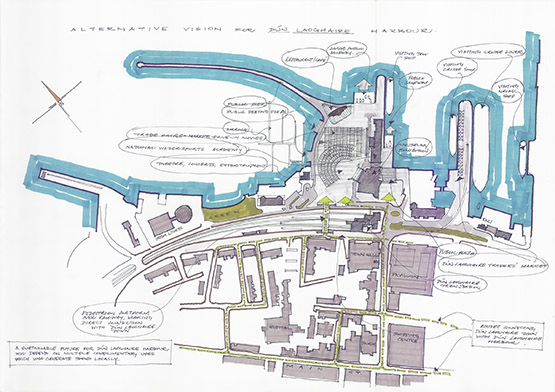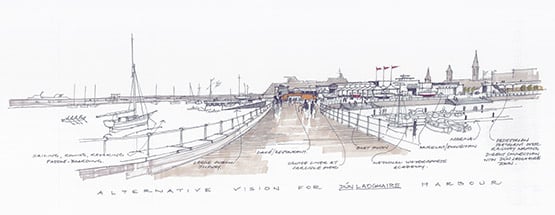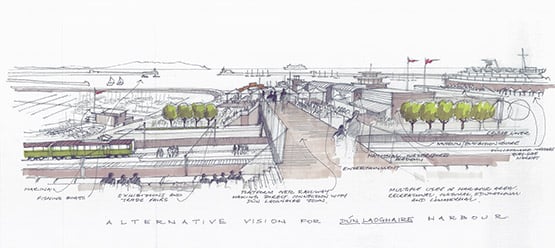Displaying items by tag: Dun Laoghaire
#CruiseBerth - Would a next-generation cruise berth in Dun Laoghaire actually do more harm than good?
That's the position of former Dun Laoghaire Motor Yacht Club vice commodore Dermot Reidy as the oral hearings on the controversial cruise berth proposal come to a close.
Writing in The Irish Times yesterday (Thursday 21 October), Reidy describes the Dun Laoghaire Harbour Company's ambitious cruise liner terminal plans as a "white elephant" and equates it with the retail over-expansion that has all but killed off the town's beleaguered Main Street.
"Dún Laoghaire needs cruise ships, certainly. But it needs ones that will dock in the harbour and contribute to the town and its economy," he writes. "It does not need 'Cities of the Seas' or five-star, floating Bulgarian apartment block-style vessels, each on the order of 17 storeys high and weighing 150,000 tons."
That's a notion supported by engineer Liam Shanahan, who told An Bord Pleanála's hearing on Wednesday (21 October) that the term 'cruise ship' in the context of the harbour company's planning application is a misnomer when such vessels are typically more than 11 storeys high and are comparable to "a mountain on a hull, with a power plant inside" – generating mass amount of air pollution when berthed.
Reidy, who supports an alternative future for Dun Laoghaire as a centre of sporting excellence, goes a step further by comparing the town's harbour to Phoenix Park as an amenity for both public and private use, and suggesting that the harbour's management be reorganised "into the existing structures that are available and willing to run them: the people via their elected councillors."
The oral hearings on the Dun Laoghaire cruise berth plans conclude today (Friday 23 October), with a final decision due by 8 January 2016.
Dun Laoghaire Cruise Berth Is 'Financial Gamble' Says TD
#CruiseBerth - An "unquantifiable financial gamble" is how local TD Richard Boyd Barrett described the proposed Dun Laoghaire cruise liner terminal at the first day of oral hearings into the plans.
According to The Irish Times, Barrett told the An Bord Pleanála hearing this past Wednesday (14 October) that no berth or harbour dredging project “in the world” at the scale of the Dun Laoghaire Harbour Company's plans that could be completed for €18 million – and claimed the scheme is "inextricably linked" with private development proposals for the harbour area.
Barrett voiced similar concerns at the 'people's protest' and boat rally held in the harbour last Saturday (10 October), in the same week that proposals for an alternative vision for the harbour as a national centre for watersports went online.
The Irish Times has more on the story HERE.
Proposal For National Watersports Centre In Dun Laoghaire Now Online
#DunLaoghaire - Proposals for a National Watersports Centre for Dun Laoghaire at the former HSS terminal are now online.
As previously reported on Afloat.ie, the idea was recently proposed by the Dun Laoghaire Combined Clubs (DLCC) to Dun Laoghaire-Rathdown County Council as they made their submission to the oral hearings on plans for a next-generation terminal for cruise liners in the harbour.
Those plans have attracted significant opposition in the locality, as evidenced by the large turnout for the joint boat rally and protest march against the scheme last weekend.
Rather than 'dividing' the harbour, as many opponents fear the cruise terminal would do, the DLCC say development of the HSS terminal as a 'National Watersports Academy' would help protect Dun Laoghaire's waterfront "as an outstanding recreational harbour and sporting amenity of national significance".
Based on the example of similar facilities in Pwllheli, Weymouth and Medemblik, the proposal envisages that Dun Laoghaire could host between 20 and 30 major events at such a centre throughout the year, "generating substantial additional revenue" for the town.



The complete proposal is available as a PDF to read or download HERE.
In 2010, The Irish Marine Federation (IMF) published a case study on the socio-economic significance of the 2009 Volvo Dun Laoghaire Regatta. The biennial event attracted an entry of 449 entries and is the biggest regatta in Ireland. Over four days, the study (carried out by Irish Sea Marine Leisure Knowledge Network) found the event was worth nearly three million to the local economy.
Boat Rally Against Dun Laoghaire Cruise Berth Tomorrow
#CruiseBerth - Royal St George Yacht Club members will host a boat rally in Dun Laoghaire Harbour tomorrow Saturday 10 October at 1pm in support of the People's Rally against cruise liner berth proposals taking place at the same time at the People's Park.
Club members are called to meet with their boas at the harbour mouth for one hour, with the intention of massing a flotilla of boats in the shape and size of the proposed 435-metre cruise pier, which critics say could split the south Dublin harbour in two and bring to an end generations of harbour sailing.
The fleet will be chaperoned, choreographed and photographed on the day by Royal St George club members who will assist in club ribs on VHF channel 72.
The protest takes place just days before the first official oral hearing into the cruise berth plans, which have already faced more than 150 objections.
Four volunteer crew members at Dun Laoghaire RNLI have been recognised this week for their commitment to the charity that saves lives at sea.
Kieran O’Connell, Eamon O’Leary, Stuart Kane and David Branigan have collectively provided 120 years’ service to the RNLI. The four who continue to volunteer their time as crew, were presented with a Bar to Long Service badge in Dun Laoghaire last night.
Kieran O’Connell who is also station mechanic, started as a volunteer crew member at Youghal RNLI in County Cork in 1983 where he served both on the all-weather and Atlantic 75 inshore lifeboats. He became station mechanic in 1995 and later accepted the same full-time position in Dun Laoghaire in 1998 moving with his wife Mary and their two daughters. When not on call, Colley is a keen drummer and also has an active interest in his former occupation as a fisherman.
Eamon O’Leary was one of the first volunteer recruits at Dun Laoghaire RNLI when the original D class inshore lifeboat was placed on station in August 1985 on a trial basis before becoming fully operational on St Patrick’s Day 1986. He later became a crew member on the Waveney class all-weather lifeboat, the John F Kennedy and more recently was appointed Second Coxswain on the current all-weather lifeboat the Anna Livia. A fire officer by occupation at Dublin Airport, Eamon who is married to Mary, received a ‘Person of the Year’ award in 1990 for a rescue on Killiney Bay.
Stuart Kane was another of the 1985 recruits who served both on the inshore and all-weather lifeboats before the arrival of the Trent class all-weather lifeboat in 1995. He was a senior helm on the inshore lifeboat for several years before becoming second mechanic and more recently Deputy Second Coxswain on the all-weather lifeboat. Stuart is married to Sharon, a former crew member who joined Dun Laoghaire RNLI in 1985 also. Their son Craig is now a crew member, continuing three generations of lifeboat tradition in their family.
David Branigan is the last of the 1985 recruits who joined in August that year. David initially served on the inshore lifeboat including a period as a senior helm and later joining the all-weather lifeboat when the Anna Livia arrived in 1995. Like all RNLI volunteers, David attended the RNLI College in Poole and was appointed Deputy Second Coxswain on the all-weather lifeboat. A professional photographer and journalist, he is also the station’s lifeboat press officer. Married to Jennifer, they are expecting their first child next month.
Since 1985, lifeboats at Dun Laoghaire RNLI have launched 1,360 times with crews saving 157 lives and rescuing 1,151 more.
Speaking after presenting the four long service badges, Owen Medland, RNLI Divisional Operations Manager, said: ‘Most lifeboat crew members are volunteers who come from all walks of life and give up their time and comfort to save lives at sea. David, Stuart, Eamon and Collie respond at a moment’s notice when their pagers go off. They are regularly called away from their families, their beds and their work, any time of the day, any day in the year. In addition, over the last 30 years, they each have invested several hours to train and upskill. Their lifesaving work is essential, often difficult and sometimes dangerous but they each do it selflessly, with courage, bravery and dedication, and on behalf of the RNLI, I would like to thank them for that.’
Fireball 'Just for Fun' Try Out Sailing Initiative in Dun Laoghaire
The third Fireball Fun Day took place today at the DMYC in Dun Laoghaire under the direction of class captain Marie Barry. The idea, says Barry, is to show what an 'exciting, stable, affordable boat the Fireball is to sail'.
Top Fireball helmsman Conor Clancy took new crew, Tim Crowe out for a sail as part of the weekend class effort that as well as supporting newer members of the fleet also lets complete novices try out Fireball sailing.
Barry says the class will have more opportunities for new sailors to participate in the Spring, and for experienced sailors there will be slots available in the Fireball Leinsters at Clontarf Yacht & Boat Club on October 17 and 18 and of course during the DMYC Frostbites from November through to late March.
#CruiseBerth - Objections to the Dun Laoghaire Harbour Company's ambitious cruise liner terminal proposals face number more than 150 ahead of oral hearings into the plan, as The Irish Times reports.
And one submission, from the Water Wags Sailing Club, even draws on marine engineering experience to argue that the scheme as it stands poses "real and significant risks to the stability of the harbour piers".
The club's position was among a host of submissions to An Bord Pleanála along with those of local sailors, the harbour's long-standing yacht clubs and their representative body the Dun Laoghaire Combined Clubs (DLCC), which organised a briefing session earlier this week to advise members on making their own voices heard.
Complaints have highlighted environmental concerns around the dumping of silt from channel dredging necessary to accommodate larger cruise ships, and the impact a next-generation cruise liner terminal would have on recreational and sports boating in the South Dublin harbour, with campaigners previously calling for an 'alternative vision' for Dun Laoghaire that makes a virtue of its existing benefits.
Indeed, along with its own submission, the DLCC has made a proposal to Dun Laoghaire-Rathdown County Council that the harbour be protected "as an outstanding recreational harbour and sporting amenity of national significance", and that the former Stena HSS terminal be repurposed as a 'National Watersports Academy' along the lines of the recently opened world-class facility at Pwllheli in North Wales.
The DLCC's presentation to DLRCoCo can be downloaded below.
Royal St. George Yacht Club in Dun Laoghaire will follow up its inaugural Elmo Trophy Team Racing trophy next month when the country's largest yacht club stages the Irish Team Racing Championships 2015 from 7th–8th November.
The event is for three boat teams and will be sailed in RSt.GYC supplied Firefly dinghies.
ISA Medals will be awarded to the first three Irish teams, and to the first Irish Youth team (subject to a minimum of three entries). In addition, the first Irish teams in each category may be selected to represent Ireland at any International team racing event in 2016.
More details downloadable below.
Briefing Session Ahead Of Oral Hearing On Dun Laoghaire Cruise Berth
#CruiseBerth - The Dun Laoghaire Combined Clubs (DLCC) will host a briefing session tomorrow evening (Wednesday 30 September) ahead of next month's oral hearing on the Dun Laoghaire cruise liner berth plans.
The briefing, which starts at 7pm at the National Yacht Club, will advise club members on how to participate in An Bord Pleanála's oral hearing process, which begins with a preliminary meeting on Wednesday 7 October before the hearing proper commences on Wednesday 14 October.
The briefing will be conducted by Ann Mulcrone of Reid Associates, Planning Consultants, who has acted as chief co-ordinator for the submission prepared by the DLCC over the Dun Laoghaire Harbour Company's proposals for a next-generation cruise liner berth in the harbour.
Public Meeting On Dun Laoghaire Cruise Liner Plans Tomorrow
#CruiseBerth - Richard Boyd Barrett TD and local author Alison Hackett are among the speakers lined up for a public meeting on Dun Laoghaire Harbour's controversial cruise liner berth plans tomorrow evening (Monday 7 September).
Activist group Save Our Seafront is hosting 'An Alternative Vision for Dun Laoghaire Harbour' at 8pm in The Kingston Hotel to discuss the Dun Laoghaire Harbour Company's proposals for a next-generation cruise liner terminal that Boyd Barrett and Hackett agree would "destroy" the unique aspect of the harbour.
Other speakers on the night will include An Taisce's Fergal McLoughlin and Liam Shanahan of the National Yacht Club, whose joint submission to An Bord Pleanála over the cruise berth plans (as a part of the Dun Laoghaire Combined Clubs) was recently published online.




























































